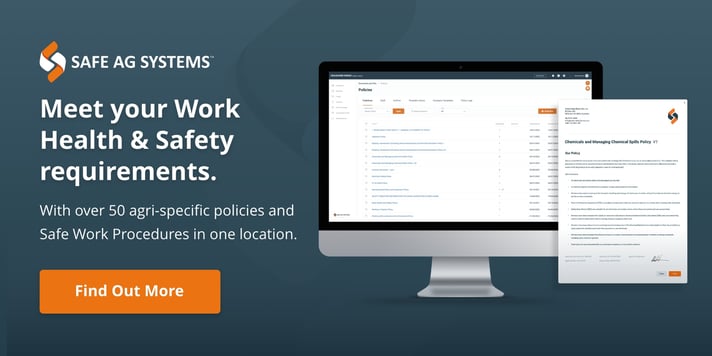As we near the seeding season for agricultural farms, it's a great time to get everything sorted out for a safe and successful kickoff to the season.
The horticulture industry and its workers face a real risk when it comes to health and safety, there are a range of potential hazards that they are exposed to on a daily basis. Due to the nature of the work, members of the horticulture industry can be found in a range of workplaces including nurseries, vineyards, market gardens and plant wholesalers.
In the 2018 Priority Industry Snapshot, Nursery and floriculture production recorded muscular stress as the main cause of injuries, 19% were due to listing, carrying or putting down objects, and another 15% were due to handling objects. Whilst in vegetable growing, had similar causes of injury, the main cause of fatalities was listed as a rollover of non-road vehicle (33%).
Australia is renowned globally for its high-quality status as a top provider – with every item cultivated, harvested, packaged, and moved following rigorous environmental and food safety protocols. In this article we are going to focus on the top 5 most common hazards in horticulture.
Muscular Stress
Repetitive tasks are often required in agriculture in general, however, the horticulture industry entails a lot of this, especially when it comes to heavy objects and manual handling. Sprains and strains are among the most common musculoskeletal disorder, and are a result of awkward positions for long periods of time, awkward lifting, push/pull motions and through repetitive movement such as fruit picking or pruning.
As an employer you are responsible for introducing and maintaining effective control measures, these can come in the form of mechanical aids (trolleys, hoists or ramps) to replace any manual handling where possible, suitable training, supervision and safe work procedures.
Machinery, Equipment and Plant
Horticulture utilise a range of farm machinery and equipment to make the workload easier, but often this comes with the greater risk of injury. Powered mobile plant often includes tractors, forklifts, elevated work platforms, ATVs/quadbikes, motorbikes and slashers. Incorrect use can result in harm to the operators, passengers, bystanders and damage to farm property structures. No one should be working with machinery or equipment without the proper required training, PPE and license.
Not only can machinery cause physical harm, it can also cause permanent hearing loss due to noise levels. Unfortunately this can go unnoticed over long periods of time, but noise exposure exceeding 85 decibels [dB(A)], leads to irreversible, permanent hearing loss. Read more about the most common tractor injuries.

Trips and Falls
Uneven ground and unlevelled terrain can results in slips, trips and falls for horticultural workers. Often grouped in with manual handling, falls on the same level directly resulted in injuries to 13% of the agricultural workforce indicating a key health and safety issue in the industry. This could be the result of slipping on a wet floor due to inappropriate footwear, tripping over a hose or other objects, and carrying items across uneven flooring.
Hazardous Chemicals and dangerous goods
Hazardous chemicals (Hazchem) have been defined by WorkSafe QLD as, “the name given to the group of chemicals classified as hazardous for use at workplaces according to the GHS. The GHS classification system focuses on chemicals with acute and chronic hazards to health and safety in the workplace.”
Whilst dangerous goods have been described by Work Safe Victoria as “substances that are corrosive, flammable, combustible, explosive, oxidising or water-reactive or have other hazardous properties. Dangerous goods can cause explosions or fires, serious injury, death and large-scale damage.”
Hazardous chemicals and dangerous goods in the horticultural industry can include fertilisers, pesticides, herbicides and fuels. These chemicals result in an allergic reaction when coming in contact with skin and eyes, or they can be inhaled and ingested, leading to headaches, nausea, loss of consciousness and ultimately exposure and be fatale.
It is important agribusinesses provide an SDS, recording important information regarding that specific chemical, emergency details and first aid procedures. Hazard chemical and substances must also be stored safely in a locked location with the appropriate signage and labelling.

UV radiation, heat and cold
Often workers in agriculture are exposed to the elements of nature, meaning the hot and cold temperatures throughout summer and winter. For those that work outdoors they are also exposed to high UV levels, which could result in sunburn or worse, skin cancer. Those not exposed to UV radiation can still suffer heat stress or heat stroke, whilst colder conditions can affect your workers ability to concentrate. Extreme temperatures can impact feeling in limbs. Consider your safe work procedure for working in extreme weather as well as other options to reduce the risks such as schedule regular breaks and PPE, this could include a long sleeve shirt, wide brimmed hat, sunscreen, wrap-around sunglasses and availability of shade.
Where is the industry going?
Farmers in Australia offer over 90 distinct types of fresh produce, including fruits, vegetables, and nuts. The Australian Horticulture sector contributes $16 billion to the economy, with almonds being the largest contributor to exports, based on value.
Latest figures reveal a combination of successes and struggles for the Australian horticulture industry, which is dealing with a variety of obstacles; nonetheless, the future looks promising, with the overall value of production rising by 2.8 percent to $16.3 billion.
In every state and territory across the country, there are over 10,500 companies operating, each employing over 130,000 individuals. Small-scale family farms are the main producers and suppliers, adopting new technologies to support challenges and opportunities so why should safety be any different?
Topics: Health and Safety in Horticulture
Disclaimer: Content on this website may be of relevance to users outside of Australia, but content links and examples are specific to Australia. Please check with your local authority for your country and industry requirements.












